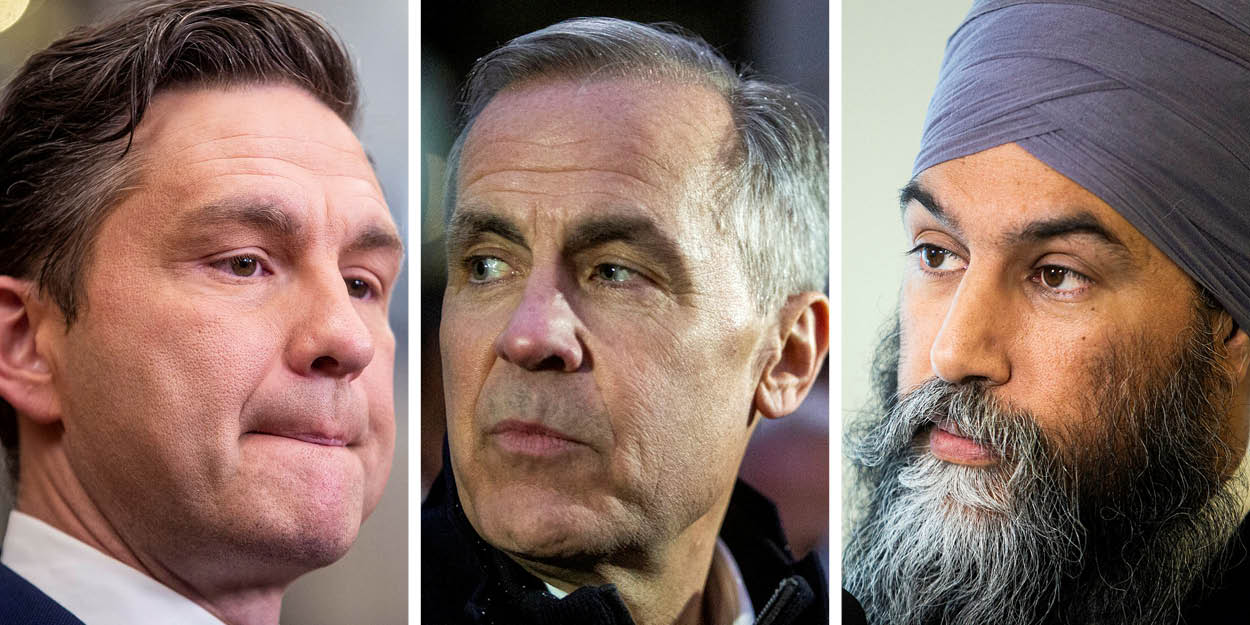Meta ad spending indicates Conservatives ready for election whenever, and whoever the Liberals choose, say strategists

As the Liberal Party prepares to choose its next leader, the three major parties are rolling out their pre-election campaign ads as they fight for Canadians’ limited attention. Yet, as the Tories and Grits have begun flexing their digital muscles with six-figure-breaking spends, digital communications experts say the New Democrats can’t keep shadowboxing during commercial breaks.
The Liberal Party’s newest 30-second TV ad, Made-In-America, started airing last week, and showcases a series of similar remarks from Conservative Leader Pierre Poilievre (Carleton, Ont.) and United States President Donald Trump.
According to a Feb. 28 press release, the new ad caps off what the Liberals say was the “best-ever” first-quarter “grassroots fundraising” total in the party’s history. The party notes that the total was achieved without the $350,000 registration fee required by its leadership contestants.
The party would not disclose the exact amount it raised in the first three months of 2025. According to data published by Elections Canada, the Liberals’ previous first-quarter record was in 2016, with a total of $4.03-million raised in the first three months.

The federal parties’ first-quarter financial returns for 2025 must be submitted to Elections Canada by April 30.
On Feb. 27, the Conservatives also released a 15-second ad, Nobody’s Weaker, in which they accuse Liberal leadership candidate Mark Carney of “[selling] out Canada” for his involvement in Brookfield Asset Management’s move of its headquarters to New York during his tenure as board chairman.
Carney has previously attempted to distance himself from the decision, saying shareholders formally approved it after he left the company to run for Liberal leader in January. However, company disclosures indicate the move had already occurred before the approval was needed.
The ad will run in both French and English on digital platforms, according to a Conservative Party press release that teases a similar 30-second ad to begin airing on television “soon.”
The new Conservative ad follows a previous digital ad, If Carney Wins, Canada Loses, released on Feb. 14, which branded the former central banker as “Sneaky Carney,” as well as a series of press conferences held by Tory MPs in the days surrounding the Liberal leadership debates, demanding disclosures and greater transparency from the presumed frontrunner.
On Feb. 20, the New Democrats also unveiled their first $500,000 “pre-election” television ad, Fighting For You. The ad features party leader Jagmeet Singh (Burnaby South, B.C.) sparring in a boxing ring, interspersed with clips of his childhood and family life.
According to a Feb. 21 press release, the NDP will spend $500,000 on 30-second English-language ads to demonstrate “who [Singh] is fighting for and what motivates him.”
While only the NDP has disclosed the budgets for its television ads, the party’s digital advertising has not seen the same significant increase of the other two parties.

According to Meta’s Ad Library, from Feb. 17-23, the NDP spent $2,243 across the party’s and Singh’s official pages. The NDP’s week-to-week spending has remained within the $1,000-3,000 range since the beginning of January, excluding the week of Dec. 30 through Jan. 5, when its spending jumped to just over $6,500.
In comparison, the Conservatives spent a combined $104,511 on Meta ads over the same mid-February period, an eight-per-cent increase from the previous week, and more than double the $47,980 they spent in the first full week of February.

While the Liberals’ Feb. 17-23 combined Meta ad spending dropped by roughly 28 per cent to $67,529 from the previous week’s $93,685, that Feb. 10-16 total represented a more than 860-per-cent increase from the $9,747 it spent from Feb. 3-9.

Former Liberal staffer Dan Arnold told The Hill Times that while the governing party’s spending on all platforms will remain elevated as the leadership race wraps up and election expectations heighten, he believes the previous week’s boost had far more to do with the Conservatives.
Arnold, now chief strategy officer with Pollara Strategic Insights, noted that the big spending week coincided with Poilievre’s “Canada First” rally on Feb. 15, and that most ads purchased that week focused on pre-empting a presumed Conservative “rebrand” by attempting to tie the event to Trump’s “America First” slogan.
While Arnold said he expects the Liberals’ spending to trend back to more sustainable levels, he’s watching for the largest ad buys to occur once the party’s new leader is chosen on March 9.
The party also benefits from the individual spending by the leadership candidates, with each person able to test a wider variety of messages.
Since Jan. 20, the Liberal leadership contestants have spent $191,351 on Meta ads, with Carney leading the pack at $142,063, thanks primarily to the $117,737 his campaign spent Jan. 20-26.


Cole Hogan, a Conservative digital ad strategist and principal at GT, told The Hill Times he will be watching the Liberals’ total spending to indicate when the next election will be called. He noted that he would look for similar but sustained spending, which he recorded from Feb. 16-22, when the Liberals’ spending broke $100,000.
The Liberals’ current reduced spending seems to be more tailored to maintaining public attention garnered from the leadership race, said Hogan. He noted that most of the Liberals’ recent Meta ads have focused primarily on email harvesting and voter-identification surveys.
While the Conservatives have spent nearly $100,000 or more in the two weeks before Feb. 23, Hogan noted the party could afford to sustain that spending for much longer, given their massive fundraising numbers.
In 2024, the Conservatives broke their own fundraising record for the second year, bringing in more than $41.7-million from 62,264 individual contributions, more than double the governing Liberals’ yearly total of $15.19-million.
Online political marketing expert Harneet Singh told The Hill Times that while the Liberal Party and the leadership candidates could be targeting their ads more efficiently, they’ve undoubtedly achieved the desired visibility.

“Their brand is resonating, and people are at least talking about them,” Singh explained. “Half the problem in political marketing is people not talking about you.”
However, now that the Liberals have garnered attention, the party’s focus needs to be on ensuring that interest can be translated into engagement, and—most importantly—mobilization on voting day, Singh said.
While the Liberals are beginning to catch up to the Conservatives, Singh views the NDP’s latest ad as an admission that the party is struggling to remain in the conversation.
“The strategy seems to be ‘please do not forget about the NDP,’” Singh said, noting the irony of depicting the leader sparring without an opponent.

“The entire airspace has been the leadership race and the Conservatives’ messaging, and they’re realizing there isn’t much space right now for the third player,” Singh explained. “They’re trying to show that they can still swing it, but if I was the NDP, my biggest concern is he swings and misses with that amount of money.”
However, Michael Roy, the NDP’s former national digital director during the 2015 election, said he believes the new ad is “exactly what an underdog like the NDP needs right now.”
“It’s attention-grabbing, and we don’t see a ton of this kind of ad in Canadian politics,” Roy told The Hill Times, comparing it to a previous ad from the Saskatchewan NDP featuring its leader Carla Beck hitting baseballs at a batting cage.
“The ads with the leader shaking hands with small-business owners or trade workers is just so stilted and unmemorable,” Roy explained. “This is genuine; it’s who the guy is, and I think that really works.”
Roy also said he doesn’t believe that spending money on Meta to feature the ad would have efficiently used the party’s limited resources, noting that those ads “demand” less attention than the unskippable ads on platforms like YouTube or TV.
“Ads that you can just scroll past aren’t very good for persuasion,” Roy explained. “If they had the nearly limitless money the Conservatives have, then they could cover everything … but TV and streaming are just higher quality because it forces you to pay attention.”
The Hill Times






 LICENSING
LICENSING PODCAST
PODCAST ALERTS
ALERTS













